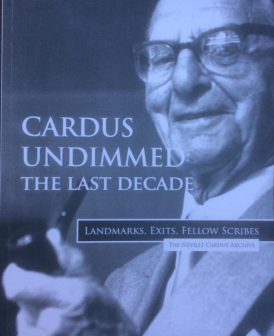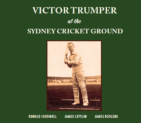Cardus Undimmed: The Last Decade
Martin Chandler |Published: 2017
Pages: 74
Author: Hilton, Bob
Publisher: Max Books
Rating: 3.5 stars

The other day for, possibly the first time ever, I met someone who shares my interest in cricket and its literature who is, in relative terms at least, young. It was an interesting experience and the conversation provided much food for thought.
In the past those I have come across who share my passion are either around about my own age or, more often, rather older. I would think that the majority of them, like me, were set on the road we have subsequently followed by something written by the late Sir Neville Cardus.
My young friend had heard of Cardus, of course, and had even read some of his work and owned one or two books. But there was not the same reverence there. It made me realise how much time marches on and that whereas for myself, my contemporaries and my seniors men like Cardus, John Arlott and ‘Crusoe’ Robertson-Glasgow stand tall above all others, they are not going to remain on that pedestal forever.
Cardus was a Lancastrian, and in the heart of Lancashire cricket, Old Trafford, the Neville Cardus Archive has been established. Its purpose is not just to keep alive the memory of the man who changed the nature of cricket writing for ever, but also to acquire material relating to him. The project has been in existence now for more than a decade, and began with a donation of more than 200 letters by Michael Kennedy, a man who was a great friend of Cardus and who shared his twin passions of music and cricket.
The Archive has also set about publishing new material and Cardus Undimmed: The Last Decade, newly released, is the fifth such book to be published. All are paperbacks of modest proportions that have appeared in numbered limited editions. The numbers however are fairly generous, varying between 250 and 500, and I believe all five remain available from the publisher, Max Books.
First to appear was, unsurprisingly in view of how the Archive came into being, My Dear Michael (40 pages), a selection from the letters donated by Kennedy. The second, which appeared two years later in 2009, was The Elusive Mr Cardus (72 pages). This was essentially more of the same, but its scope extended well beyond the Kennedy letters to include other correspondence the Archive had acquired. In 2012, perhaps inevitably, Cardus: A Reader’s Guide (32 pages) emerged. As the name suggests it is a detailed survey and bibliography of Cardus’ oeuvre.
Tucked away towards the back of Cardus: A Reader’s Guide is an update on the Archive’s acquisitions, which includes a reference to an extensive notebook kept by Cardus between 1949 and 1951. By 2014 the contents of the notebook had been edited for publication, and the result was Neville Cardus Reflects (60 pages).
And so to Cardus Undimmed: The Last Decade. Born in 1888 Cardus departed this mortal coil in 1975, so it was a decent innings of 86 years. Writing of course does not have a retirement age, and Cardus never put away his pen. His last book appeared in 1970. Full Score was not an autobiography as such, but was of that ilk and consisted of a collection of writings on a variety of subjects. There was some cricketing content, but not very much. That apart the majority of his output in his last years has not been seen in book form before the best of it was collected here. There are selections covering all of Cardus’ interests, but the content is mainly cricket related.
Although the book’s title leaves its reader in little doubt as to what its content is going to be that is in fact only part of the book, more precisely its first 44 pages. The style of the man had inevitably changed since his first forays into cricket writing almost sixty years previously, but his work is unmistakeable. Of particular interest are some of the obituaries. Writing such a piece about a lifelong friend, as of course Cardus had to do with increasing frequency as he aged, is a very different challenge to composing such a tribute in other circumstances.
In many ways more interesting however is the second and shorter part of the book which looks at Cardus’ relationships with the other cricket writing behemoths of his time. There are chapters devoted to Arlott and Crusoe as well as ‘Jim’ Swanton, CLR James and CB Fry. Cardus was, to use an expression I detest but seems for once fit for purpose, a ‘people person’ and was clearly fond of ‘Crusoe’, an ultimately tragic figure whose obituary appears earlier in the book. His relationship with Swanton could be somewhat strained, and even that with Arlott (with whom he collaborated on one book although they had separate and distinct roles) is better described as one of mutual respect rather than genuine warmth.
None of the Archive publications are recommended as an introduction to their subject, but for those who have already fallen under the Cardus spell they are well worth investing in, especially Cardus Undimmed: The Last Decade. Content wise it is the most interesting, and in this reviewer’s opinion it is also the best designed and produced.






Leave a comment